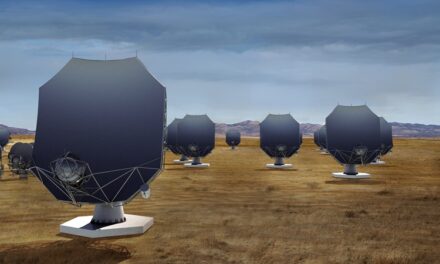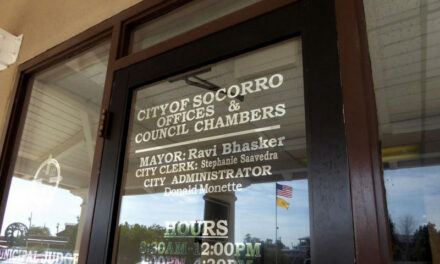As of this summer, the 29,000-plus members of Kit Carson Electric Cooperative in Taos will receive all their daytime power from the sun, contributing to a drop in customer rates of up to 25 percent.
The co-op announced those achievements in early April, capping a six-year effort that began in 2016, when Kit Carson broke away from its previous wholesale energy provider, Tri-State Generation and Transmission, to instead sign a 10-year deal with third-party power provider Guzman Energy LLC. Guzman, a Colorado-based company that’s helping electric cooperatives and municipal utilities lower their rates through renewable generation, paid off Kit Carson’s $37 million “exit fee” for the cooperative to break its long-term wholesale contract with Tri-State.
As of this June, the cooperative will make its last monthly payment on that debt to Guzman, allowing member rates to immediately drop in July, said Kit Carson CEO Luis Reyes.
At the same time, two new large solar projects will come online, allowing the cooperative to derive 100 percent of its daytime generation from 20 different solar installations that it’s been installing since leaving Tri-State.
Between the elimination of the exit-fee debt to Guzman — which all co-op members helped pay off through a monthly charge on their bills — plus the 100 percent solar achievement, the co-op’s wholesale power costs will decline by 40 percent, Reyes said. And those savings will immediately be passed on to co-op members.
“Our wholesale rates will decline from 5.5 cents per kilowatt-hour now to just 3.94 cents,” Reyes told the Journal. “It’s exciting because we’re demonstrating that with renewables, we can actually push rates down. … We’ll have some of the lowest rates for any cooperative in the state, if not the region.”
By late summer, average Kit Carson customer bills will have declined by up to 25 percent, Reyes said.
Prior to 2016, the co-op’s electric rates were directly tied to Tri-State’s wholesale charges, which Reyes estimates were about 30 percent higher than other available energy prices on the market thanks to a series of Tri-State rate hikes. Tri-State’s high rates generally reflected its dependence on expensive coal generation for nearly 50 percent of its electricity, plus sluggish efforts to replace that fossil fuel with cheaper renewable alternatives.
In addition, long-term contracts under Tri-State — which provides wholesale power to 43 distribution cooperatives in four states, including 11 in New Mexico — limited the amount of renewable generation that member cooperatives could pursue on their own, independently from the wholesale association.
Since then, Tri-State has aggressively moved to replace its coal generation with renewables to meet new climate mandates in some of the states where it operates and to stabilize its power rates. It’s also raised the amount of renewables that its member co-ops can build on their own.
Nevertheless, Kit Carson estimates that by 2026 — when its 10-year wholesale power agreement with Guzman ends — the cooperative will have saved between $50 million and $70 million compared with the costs it would have accumulated had it remained with Tri-State.
That reflects cheaper wholesale rates under Guzman — which provides power to Kit Carson to supplement the cooperative’s solar energy generation — plus decreasing costs from new solar plants continually coming online since 2016.
The co-op currently has 18 different solar facilities on its grid, 15 of them built since 2016. Those plants — which are spread throughout Kit Carson’s service territory — can collectively generate about 18.6 megawatts of electricity, supplying about 65 percent of the co-op’s total daytime electric needs.
Now, with two new large solar facilities set to come online in Taos and Angel Fire over the summer, the co-op’s solar generation will more than double to 41 MW, meeting 100 percent of Kit Carson’s daytime power consumption.
The new facilities will also include 16.25 MW of battery storage that can provide up to two hours of additional generation in the evening, or when Kit Carson’s solar facilities don’t produce up to capacity.
Kit Carson’s low, renewable-based rates are not only helping co-op members, but contributing to economic development in Taos, Reyes said.
“Local businesses are using it as a marketing tool,” he said. “They boast about deriving all their energy from renewables, which generates enthusiasm among environmentally-conscious consumers.”
Kit Carson’s achievements are inspiring other electric cooperatives and municipalities to pursue similar energy development strategies in their own communities. The City of Socorro, for example, is now working to replace the Socorro Electric Cooperative with a municipal utility that will pursue solar development to lower electric rates.
The cooperative, which launched in 1944 and buys all its power from Tri-State, has yet to pursue any solar or renewable development independent of the wholesale association. And its rates remain exorbitant, said Socorro Mayor Ravi Bhasker.
The city recently offered to buy out the cooperative, which received a cool reception from the co-op leadership. But now, the city is preparing a firm proposal to acquire the co-op’s urban infrastructure for about $24 million, which it plans to submit to the cooperative in late April.
“It’s not a secret — we’ve already made overtures that we want to buy the cooperative — but the co-op leadership told us to go pound sand because it’s not for sale,” Bhasker told the Journal. “Well, we’ve done our appraisal and now we’ll tender a direct offer.”
If the cooperative refuses to negotiate, the city is prepared to kick the co-op off its property when the cooperative’s urban right-of-way franchise agreement ends in 2024, the mayor said.
The city has been consulting with Guzman Energy, which says it can provide wholesale power to Socorro at 4.5 cents per kilowatt-hour, compared with 8.5 cents that the co-op now pays to Tri-State.
That would significantly lower rates for city residents and businesses, and also for surrounding communities, because the municipal utility would work to extend its electric service around the county.
“We’ve told people in the county that once the city acquires the co-op, we’ll continue negotiations to acquire the rest of its business in surrounding areas,” Bhasker said.
Socorro has closely followed Kit Carson’s achievements, encouraging the city to pursue an independent energy path as well, the mayor said.
“We’re excited to follow Kit Carson’s lead,” Bhasker said. “They’ve shown this can be done, that we can decrease utility rates in the state and contribute to local economic development. That’s given us confidence that we can do it too.”

















